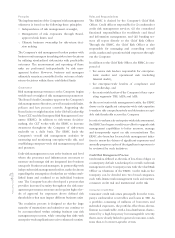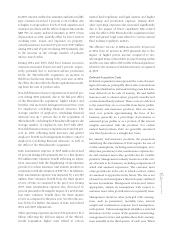American Express 2004 Annual Report Download - page 51
Download and view the complete annual report
Please find page 51 of the 2004 American Express annual report below. You can navigate through the pages in the report by either clicking on the pages listed below, or by using the keyword search tool below to find specific information within the annual report.
The following discussion of TRS’ results is presented on
a managed basis.
Revenues
In 2004, TRS’ net revenues increased 12 percent to $22.5
billion primarily due to higher discount revenue from
record cardmember spending and a greater number of
cards-in-force, higher travel and other commissions and
fees, increased cardmember lending net finance charge
revenue, from higher average lending balances, and
increased net card fees. Net revenues of $20.1 billion in
2003 were 8 percent higher than 2002 as a result of
increased discount revenues, cardmember lending net
finance charge revenue, and travel and other commis-
sions and fees.
Revenues and expenses are affected by changes in the
relative values of non-U.S. currencies to the U.S. dollar.
The currency rate changes had a favorable effect on rev-
enue growth of approximately 2 percentage points in
2004 and 3 percentage points in 2003.
Discount revenue is the Company’s largest single rev-
enue source and is primarily driven by billed business
volumes and the average discount rate earned on
those volumes. Discount revenue rose 17 percent to
$10.2 billion in 2004 as a result of an 18 percent increase
in billed business partially offset by a lower discount rate.
The average discount rate in 2004 was 2.56% compared
to 2.59% in 2003 primarily reflecting changes in the mix
of spending between various merchant segments due to
the cumulative impact of stronger than average growth
in the lower rate retail and other “everyday spend” mer-
chant categories (e.g., supermarkets, discounters, etc.).
Based on the Company’s business strategy, it expects to
see continued changes in the mix of business. This, com-
bined with volume-related pricing discounts and selec-
tive repricing initiatives, will probably continue to result
in some discount rate erosion over time. Discount rev-
enue rose 11 percent to $8.8 billion during 2003 as a
result of a 13 percent increase in billed business partially
offset by a lower discount rate.
The 18 percent increase in billed business to $416.1 bil-
lion for 2004 resulted from a 13 percent increase in
spending per proprietary basic card worldwide and 8
percent growth in cards-in-force. U.S. billed business
rose 16 percent to $304.8 billion reflecting 16 percent
growth within the consumer card business, 20 percent
growth in small business services volume and a 12 per-
cent increase within corporate services. U.S. non-T&E
related volume categories, which represented approxi-
mately 67 percent of U.S. billed business in 2004,
increased 19 percent over 2003 while U.S. T&E volumes
rose 11 percent reflecting continued strengthening
across all T&E industries. Total billed business outside
the U.S., excluding the impact of foreign exchange
translation, grew 15 percent reflecting strong double-
digit improvement across all regions. Worldwide airline
volumes, which represented 12 percent of total billed
business volumes during 2004, increased 14 percent as
a result of 15 percent growth in transaction volumes,
partially offset by a 1 percent decrease in the average
airline charge. Additionally, global network volumes
grew over 30 percent as compared to last year.
U.S. cards-in-force rose 9 percent in 2004 to 39.9 million
reflecting the benefit of continued strong card acquisi-
tion spending, an improved average customer retention
level within proprietary issuing business and strong
growth in U.S. network cards. Non-U.S. cards-in-force
increased 6 percent in 2004 to 25.5 million due to
growth in both proprietary and network partnership
cards. Worldwide network cards-in-force increased
over 30 percent during 2004. In 2003, U.S. cards-in-force
rose 4 percent to 36.4 million and non-U.S. cards-in-
force increased 9 percent to 24.1 million.
Cardmember lending net finance charge revenue of
$4.1 billion rose 4 percent in 2004 primarily due to 9 per-
cent growth in the average balance of the managed
lending portfolio partially offset by lower average
yields. The net interest yield on the managed worldwide
lending portfolio decreased to 8.6% in 2004 from 9.1%
in 2003 reflecting a higher average proportion of the
portfolio on introductory or promotional rates during the
year, lower revolve rates, and improved credit quality,
which reduces the proportion of the portfolio at default
interest rates. In 2003, cardmember lending net finance
charge revenue increased 7 percent to $3.9 billion.
Net card fees increased 4 percent to $1.9 billion in
2004 reflecting the growth in cards-in-force. Key aspects
of the Company’s business strategy are retention of
cardmembers as well as driving growth in cards-in
force, whether organically, through related business
opportunities, or through joint ventures and acquisi-
tions. The average annual fee per proprietary card-in-
force decreased to $34 in 2004 from $35 in 2003 which
reflects the increase in the number of fee-free cards
issued by the Company. Net card fees increased 6 per-
cent to $1.8 billion in 2003 reflecting growth in cards-
in-force and the benefit of selected annual fee increases.
Travel commissions and fees rose 19 percent to
$1.8 billion in 2004 due to a 25 percent increase in travel
sales, reflecting the Rosenbluth acquisition in late 2003
and improvement within the travel environment,
AXP
AR.04
49
Financial Review
























